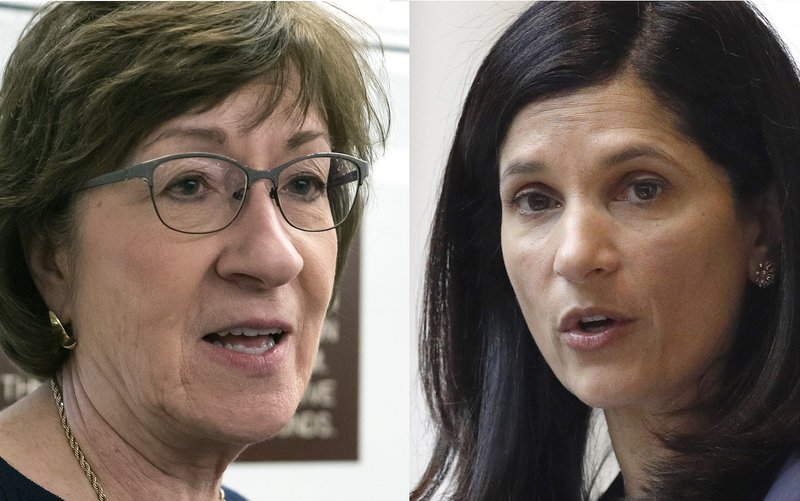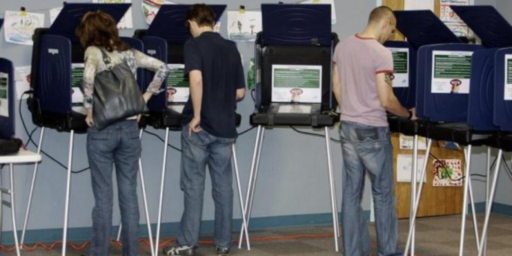Ranked Choice Voting Could Determine Maine Winner
The rules for counting votes matter.

Whether Susan Collins is re-elected—and, potentially, whether Democrats regain control of the United States Senate—could be impacted by the state’s relatively novel method of counting votes.
NPR (“Ranked-Choice Voting Could Play A Deciding Role In Maine’s Senate Race“):
One of this November’s closest and highest-profile U.S. Senate races could turn on a unique way of voting in Maine.
There, Republican incumbent Susan Collins is defending her seat against Democratic state House Speaker Sara Gideon as well as two independents. Polls show a close contest between Collins, who’s seeking her fifth term, and the well-funded Gideon.
And Maine voters will use the ranked-choice voting system, which allows them to rank their choices among the four Senate candidates.
[…]
In this year’s U.S. Senate race, one candidate, independent Lisa Savage, has used ranked-choice voting in her messaging, telling voters to make her their first choice and the Democrat Gideon their second one.
University of Maine political science professor Mark Brewer says that’s problematic for Collins.
“In a ranked-choice voting scheme, assuming that Savage’s supporters list Gideon second, which Savage is asking them to do, this now turns into a disadvantage for Collins,” he says.
But it’s unclear how the votes for the two independent candidates will break, with recent polls showing each with roughly the same share of the vote.
In principle, I support the idea of ranked-choice or instant-runoff voting. It simply makes sense to elect officeholders who have the support of a majority of the constituency.
In practice, I’m less sure. In most ranked-choice systems, and I gather in Maine’s case, the way it works is like this: If any candidate gets a majority of 1st-choice votes, they’re the winner. If not, the bottom finisher is eliminated from the contest and 2nd choice of that candidate’s voters now get a vote. This continues until someone has a majority.
In a race where there are two major-party candidates and one significant third party, that makes sense. So, for example, if there is a Green Party candidate who takes 8 percent of the vote and almost all of those who voted for said candidate preferred the Democrat to the Republican, those voters are allowed to both express their true preference and still have their vote “count” in deciding between the two major-party candidates.
But what about this situation? Here, we have four candidates. Let’s say that the fourth-place candidate’s voters preferred Collins to Gideon and that said candidate’s votes were sufficient to put Collins over the top?
But what if the third-place candidate, who by definition received more votes than the fourth-place candidate, was preferred by Gideon second-choicers? Yet, even though the point of ranked-choice voting is to eliminate the “wasted vote,” that’s exactly what happens here. Even though there may well have been enough of their votes to give Gideon the win, they don’t matter under this system.
Obviously, this would be compounded further in a race with five, six, or seven candidates who drew significant votes.
Wouldn’t it make more sense to eliminate all of the non-finalists (that is, everyone other than the top two finishers) and redistribute all of their second-choice votes?
Of course, that assumes most people’s second choice would be one of the major-party candidates. If that’s not the case, then multiple elimination rounds could also have perverse effects.
UPDATE: To quote the late, great Emily Litella, “Never mind.” As just about every commenter figured out, it is mathematically impossible for this method to push a candidate over the 50 percent threshold and there be enough votes remaining for another candidate to get more votes. I would have figured this out myself had I drawn the table and done the numbers.






The Maine system redistributes votes from the last place candidate until one candidate has >50% of the vote, using multiple rounds if necessary (if I recall correctly). The winner will be the one that the majority of voters agree should have the job, even if that person wasn’t their first choice. Could you elaborate on how a perverse outcome could occur? I can imagine a few ways that the system could produce an unexpected result, but none that I would call perverse, so I’m wondering what I’m missing.
If 2+4 is greater than 50% then I don’t see how 1+3 could also be greater than 50%. Even though there are multiple choices, each voter still just gets one vote per round.
@Erik: @FredW: I think my math may just be off here.
1st choice -> 2nd choice
45% A -> 20% C, 25% B
30% B -> 30% C
25% C -> 6% A, 19% B
A wins, but is arguably the least preferred candidate overall when considering the second round.
If the system works as stated in the article the method of counting is just trying to reduce labor. By counting the last place finisher first they are counting the least number of additional votes that will potentially put one of the top two candidates over the 50% threshold.
An illustrative example with made up round numbers:
1000 people vote
460 vote for A and 445 vote for B, so neither has 501 votes
50 vote for C
45 vote for D
Those 45, if they broke heavily for A could be enough to put A over 500.
In that case one party would have over 50% of the vote and votes for C wouldn’t have to be counted.
Depending on the vote count for each of the candidates it might be a foregone conclusion that the last place candidate couldn’t provide enough votes and they’d have to go up the scale.
Because I’m a small, petty person who enjoys schadenfreude, and is as innumerate as your typical Labrador retriever, I cannot help but enjoy Joyner’s mathematical difficulties.
You can craft all sorts of silly scenarios out of this, but all of them will be fairer than plurality wins it all.
What happens if no one can possibly get 50%+1 of the total vote? Do they drop the votes of the people who didn’t vote for any viable winner? Do they require everyone to rank candidates all the way down the list? Will you have to choose between two different joke candidates for your 7th and 8th choices?
@Michael Reynolds: Indeed.
@Gustopher: Yes, the only downside, really, is that we’re treating people who vote for Joke Candidate 6 as though their opinion on who should govern is as valid as those who selected a viable candidate. But, hey, it’s America.